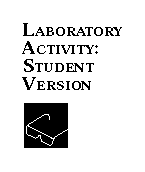
 Activity 1: Types of Reactions
Activity 1: Types of Reactions
Introduction
A large variety of chemical reactions goes on around us at all times. Classifying these reactions helps to make sense of them and enables us to predict the products. This activity gives an opportunity to learn and apply one classification scheme. There are other classification schemes that you will learn as you continue your study of chemistry.
Purpose
The purpose of this laboratory activity is to discover the characteristics of different types of reactions.
Safety
- Wear eye protection and aprons throughout the activity.
- Hydrochloric acid is caustic and corrosive. If you spill any on your skin wash it off with water and notify the teacher. Skin contact with other chemicals and solutions should be avoided.
- Dispose of the chemicals as your teacher directs.
Procedure
Before beginning the laboratory work, read through the entire procedure and prepare a data table for each part of the activity. Record all data and observations in the table.
Part I
- Determine the mass of a watch glass together with a piece of compacted copper wool approximately the diameter of a quarter.
- Hold your tongs in the hot part of a burner flame for about one minute to remove any contamination.
- With the tongs hold the copper in the hot part of the flame for 5 min. Make observations during the heating as well as after.
- Air cool the copper for one minute before you return it to the watch glass.
- When the watch glass and copper are cool determine the mass.
- Dispose of the copper as your teacher directs.
- Repeat the entire experiment with a sample of steel wool.
Part II
- Add copper(II) sulfate pentahydrate, CuSO 4 . 5H 2 O(s), to a depth of about 1 cm to a clean dry test-tube (13- x 100-mm). Observe the appearance of the copper(II) sulfate pentahydrate and record.
- Determine the mass of the test-tube and sample.
- Tilt the test-tube, spreading the hydrate so it covers about half the length of the test-tube.
- Use a test-tube holder to hold the test-tube nearly horizontal. Move it back and forth through a cool flame (no inner blue cone) so that the entire sample is heated. Make observations while heating as well as after you are finished. (You have heated too much if the solid begins to darken.) Heating will be completed after about 2 min.
- Allow the test-tube and contents to cool and determine its mass.
- Use your dropper to add a drop of water to the substance in the test-tube. Record your observations.
- Dispose of the chemicals as your teacher directs.
- Repeat this part of the activity with calcium chloride hexahydrate, CaCl 2 . 6H 2 O(s) or ammonium carbonate, (NH 4 ) 2 CO 3 (s).
Part III
- Place 5 mL copper(II) sulfate solution, CuSO 4 (aq), in a large test-tube (16 x 150 mm). Add a strip of magnesium, Mg. Make observations immediately and after 5 min.
- Place 5 mL hydrochloric acid solution, HCl(aq), in a large test-tube. Add one piece of zinc, Zn. Make observations immediately and after 5 min.
- Dispose of the chemicals as your teacher directs.
Part IV
- Pour 3 mL barium chloride solution, BaCl 2 (aq), in a test-tube (13- x 100- mm). Add 3 mL sodium sulfate solution, Na 2 SO 4 (aq).
- Pour 3 mL cobalt(II) nitrate solution, Co(NO 3 ) 2 (aq), in a test-tube (13- x 100- mm). Add 3 mL sodium phosphate solution, Na 3 PO 4 (aq).
- Dispose of the chemicals as your teacher directs.
- Thoroughly wash your hands before leaving the laboratory.
Continue


 Activity 1: Types of Reactions
Activity 1: Types of Reactions

